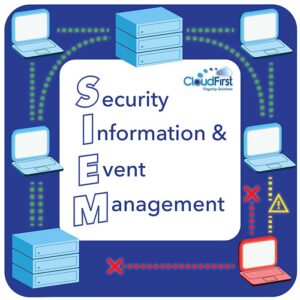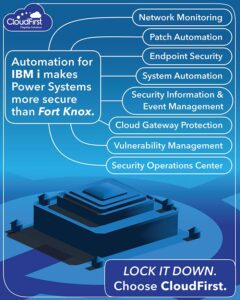The increase in cyber threats, data breaches, and regulatory compliance challenges is an ongoing stressor for corporate leadership. The rise of ransomware and the use of generative AI underscore just how fast cyber threats are evolving.
According to stats from Forbes, “2023 saw a 72% increase in data breaches since 2021, which held the previous all-time record.” Combining these concerns with the fact that “around the world, a data breach costs $4.88 million on average in 2024,” it’s clear that the threats are coming at you from every angle—and they carry with them an enormous cost.
Security information and event management (SIEM) is the first line of defense against cybersecurity threats. It enables companies to manage risk and respond to security incidents as quickly as they present themselves. Implementing SIEM isn’t just a wise way to improve your company’s security posture—it protects your organization’s reputation.
How can you protect your sensitive data and mission-critical applications with security automation? Managing your security information and event management system with the help of cloud security professionals is one of the easiest and most effective ways to safeguard your company’s most valuable assets: your data.
Decoding SIEM: The ins and outs of security information and event management systems

IBM provides this security information and event management definition: “A security solution that helps organizations recognize and address potential security threats and vulnerabilities before they have a chance to disrupt business operations.” It involves collecting and analyzing security data across an organization’s IT infrastructure.
This could include servers, routers, applications, firewalls, and even logs generated by other security devices. The goal of SIEM is to connect the dots between all this data and secure it on a centralized platform, providing a fast and efficient bird’s-eye view of the company’s security situation.
SIEM is like your chief of staff who pulls information from all your direct reports and boils it down for you, so you can manage your company more efficiently.
SIEM systems can detect potential security threats in real time through advanced analytics. A good example would be if a user account tries to access sensitive information from a new location. (You may have gotten emails like this before regarding personal user accounts for streaming services.) A SIEM tool will flag this behavior so your security team can look into it and see if there’s any suspicious activity going on.
How cybersecurity AI for IBM i fits into the bigger picture
Integrating SIEM tools with cybersecurity AI for AS/400 and other IBM Power Systems offers potent security options that complement one another nicely. A SIEM system collects and analyzes large amounts of data to identify threats, making it important in informing how your organization deals with cybersecurity.
Any insight you get from SIEM analytics can note vulnerabilities within software and other systems. Flagging these vulnerabilities makes it easy for a company to identify which patches are most critical to apply. In this way, SIEM helps you repair any cracks in your digital armor before they are exploited while simultaneously sounding the alarm when enemies are at your gates.
AI’s role in your SIEM depends on the platform or tool. Some can be integrated directly into a SIEM system, while others are plugins.
AI-enabled SIEMs use algorithms to predict threats even more accurately—and likely much faster than the tools you’re already using. Integrating AI into your SIEM automates responses and makes patch management even more efficient, since the AI can detect the need for an update and apply it without any intervention from your security team.
SIEM’s role in your security automation solution

Integrating SIEM into your security automation strategy is essential for a comprehensive approach to cybersecurity AI for IBM AIX. SIEM systems gather data from various sources, enabling organizations to detect potential threats faster and respond more effectively.
As you seek SIEM solutions, it’s crucial to consider your organization’s specific needs. According to Gartner, a robust SIEM solution should offer features like realtime monitoring, advanced analytics, and the ability to integrate with existing security tools. This ensures that businesses can leverage their SIEM system to its fullest potential.
Gartner’s findings also predicted that “90% of SIEM solutions [would] offer capabilities delivered exclusively in the cloud” by 2023. It’s well beyond that time, and it’s become clear that most SIEM solutions are moving toward cloud-based service models.
So what are the real-world consequences of having weak, inefficient, or unoptimized SIEM? Consider the 2021 Facebook data leak, where personal data from over 530 million users was exposed online due to vulnerabilities in the platform’s security measures. This incident was attributed to a flaw in the way Facebook handled user data, highlighting significant gaps in their security infrastructure. Even though the company had strong security systems in place, the breach underscored a need for continuous monitoring and security protocol updates to safeguard such sensitive user information.
This event serves as a reminder that it’s not enough simply to have security measures like a security information and event management system in place. Organizations must ensure these systems are correctly configured, regularly updated, and effectively integrated into their overall security strategy. And that’s where cloud-driven SIEM shines.
The impact of cloud-driven SIEM on cybersecurity AI for IBM Power Systems
Using SIEM in IBM Power Systems gives you even more control over your security by enabling analysis of network traffic and user behavior. But what does this look like in practice?
Kash Shaikh, President and CEO of Securonix, talks about just how costly it can be to put AI tools in place without the proper infrastructure. “Cost is a challenge, and while security is important, some of the SIEM solutions in the market are very expensive. And some of them are not necessarily providing a comprehensive view of what’s going on from a threat perspective to be able to secure the environment and protect the business.”
Shaikh is highlighting what many companies already know: a robust SIEM system is vital, but it’s challenging to get one off the ground without the right foundational tools in your arsenal. That’s where cloud providers make all the difference. They offer scalable SIEM solutions that integrate seamlessly with your current IT infrastructure, reducing upfront costs and maintenance burdens.
Use cloud-driven SIEM to access the advanced analytics and threat detection capabilities that come with AI solutions—without heavy investment in on-premises systems. Moreover, cloud providers offer scalability and flexibility, allowing you to adjust your security measures as your needs evolve.
Security automation in a neat package from cloud providers

Cloud providers like CloudFirst offer innovative solutions such as ezAutomate, which simplifies the implementation of security automation to make it easy to set up and manage. By integrating with platforms like IBM’s QRadar, organizations can enhance their SIEM capabilities. QRadar is a platform that analyzes security data from multiple sources, much like other SIEM tools.
But it also “uses multiple layers of AI and automation to enhance alert enrichment, threat prioritization and incident correlation—presenting related alerts cohesively in a unified dashboard, reducing noise and saving time.” IBM says analysts saw a 90% reduction in time spent investigating incidents and a 60% reduction in the risk of experiencing a significant security breach when using QRadar SIEM.
By integrating solutions like ezAutomate and QRadar, even businesses with limited cybersecurity expertise can take advantage of advanced security features without extensive training or resources.
Leverage cloud solutions and SIEM for a holistic approach to security
You could wait to take action until after there’s been a security breach. Or you could enhance your organization’s cybersecurity by investing in a powerful SIEM solution with the help of a leading cloud provider.
CloudFirst also offers comprehensive support and resources to help you manage your security solutions to their full potential. Taking advantage of cloud solutions and SIEM technologies creates more secure storage for your data. The result is the right level of protection for both your business and your customers.
Ready to learn more about our cutting-edge security information and event management systems? Get in touch with CloudFirst today to discuss your needs and discover a better strategy to leverage cybersecurity AI for IBM Power Systems.

